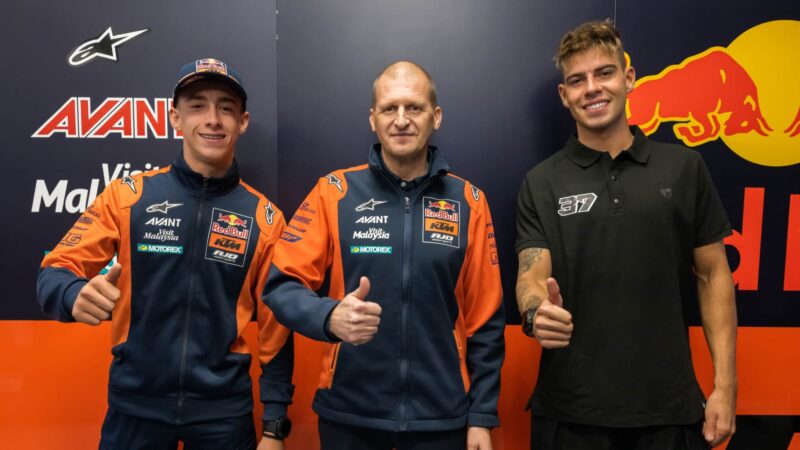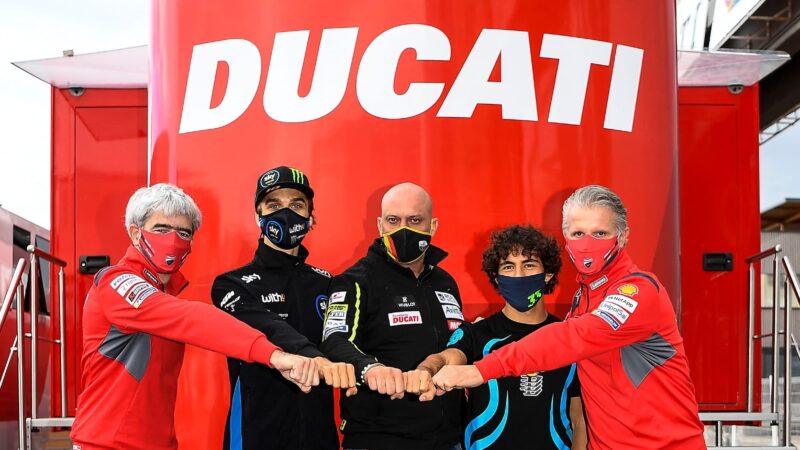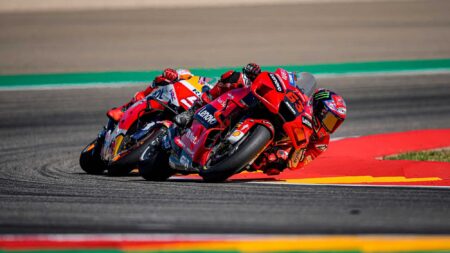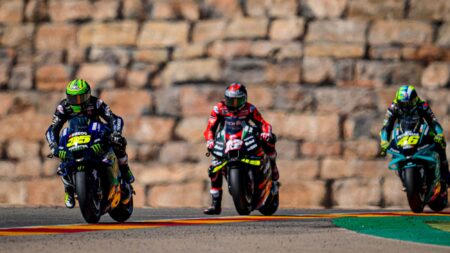Both current Red Bull KTM MotoGP riders Brad Binder and Miguel Oliveira have followed that same road mostly all the way through from Rookies.
While other factory bosses praise Red Bull KTM’s system, some of them think the Rookies Cup especially gives KTM an unfair advantage in building its future in MotoGP.
The case of Ajo Moto2 rider Raúl Fernández brought the argument into full focus last month. Fernández finished third in the 2016 Rookies Cup, won two races in his second Moto3 season, with Ajo’s team, and is currently fighting Ajo team-mate Remy Gardner for the Moto2 crown.
No surprise then that Yamaha was chasing the 20-year-old Spaniard, fighting to get his signature on a MotoGP contract for 2022. Fernández wanted to sign with Yamaha to ride its rookie-friendly Yamaha YZR-M1 in the factory’s MotoGP B-team, but he is still under contract to Red KTM Bull from his days in the Rookies.
Fernández tried to buy himself out of the contract, for a reputed half million Euros, but the crucial paragraph in the paperwork reads in KTM’s favour, so he has no choice but to stay with the Austrian factory and ride a Tech 3 RC16 in 2022.

Kingmaker Aki Ajo with his 2022 Red Bull KTM Moto2 line-up – former Red Bull Rookie winners Pedro Acosta and Augusto Fernández
KTM
On the other hand, KTM did allow Jorge Martin to buy himself out of the deal he had signed when he was a Red Bull Rookie to join this year’s Pramac Ducati team.
“The Rookies Cup is absolutely fantastic, but I don’t think it’s fair that it’s always [since 2007] with one manufacturer,” says factory Ducati team manager Davide Tardozzi. “I don’t know if it’s true but somebody told me they can lock guys into contracts for five years. If this is true, it’s not good, because it’s like a monopoly. I don’t think they should have the possibility to lock young riders for five years; it’s not correct.
“On the other hand, Ajo’s Moto2 and Moto3 teams are completely correct, no problem at all, because they grow up riders in the proper way because Aki is an incredible team manager, very clever.”
“All the factories need to think about the next two or three years, not about tomorrow morning”
It’s no surprise therefore that Ducati is aiming to replicate the KTM GP Academy system through a long-term agreement with the VR46 Riders Academy, to develop youngsters for its future MotoGP line-up.
“Valentino (Rossi), Uccio (Salucci) and Albi [Trebaldi] started VR46 to give possibilities to young Italian riders, because some years ago all the young guys coming through were Spanish,” adds Tardozzi. “They invested a lot of money and did a great job, with two Moto2 champions and now two riders in MotoGP.
“From what I hear they would like to open up VR46 to non-Italians. I know they are thinking how to improve. At the moment they have a fantastic ranch with incredible facilities.
“How they manage young riders and how they help them is very, very good. It’s the way they do everything – how they manage riders away from the track, how they manage riding at the ranch, at the gym and so on. They are really well prepared 360 degrees.”
Veteran MotoGP manager Carlo Pernat believes that MotoGP’s other four factories – Aprilia, Honda, Suzuki and Yamaha – need to establish similar programmes if they’re not to get left behind in the coming years,
“The Rookies Cup and the way KTM works is beautiful – now only Ducati tried to defend against this by making their own riders,” says Pernat, who ran Aprilia’s GP operation years ago and been personal manager to Max Biaggi, Loris Capirossi, Marco Simoncelli, Andrea Iannone, Enea Bastianini and others.

Last year VR46 did a long-term deal with Ducati – here is VR46 rider Luca Marini (second left) with Ducati’s Gigi Dall’Igna (left) and Paolo Ciabatti (right)
Ducati
“All the factories need to think about the next two or three years, not about tomorrow morning. This is why I don’t understand Yamaha because they put [Andrea] Dovizioso on the bike in their second team next year. Dovizioso is tomorrow morning’s rider, he isn’t the future.”
Spotting talent early and making deals before young riders can ask too much money is another aspect of chasing the signatures of children, because (like it or not) this is the way MotoGP is right now.
“Davide [Brivio, Suzuki’s team manager until the end of last year] had a good idea in signing rookies for the Suzuki MotoGP team: Maverick Viñales, Álex Rins and Joan Mir, but Suzuki always had to pay a lot of money – around €1.5m, whereas Ducati could pay a rider €200,000 to get them in a satellite team. It’s a big difference.”
Perhaps one of the issues facing this side of MotoGP is the single-engine Moto2 championship. In the past factories could sign young riders for their 125cc or 250cc teams, using those as a road into the premier class. Aprilia, Honda, Suzuki, Yamaha and others all had their own 250cc teams. But not anymore.
“All the manufacturers need to build low-cost GP-style bikes like that. They need to get on top of this.”
Honda has its Team Asia squad, created to develop talent from the Asian region, and KTM has Ajo’s outfit. But it’s easy to see why most factories aren’t keen to be involved in a class that’s uses a rival’s engine.
There are others in the paddock who are also trying to build new roads into MotoGP, that might help other manufacturers do the kind of thing KTM and Ducati are doing.
Former Kawasaki and Suzuki MotoGP rider John Hopkins – now working with the American Moto2 team and running its Los Angeles-based rider academy – is one of them.
Like Tardozzi and Pernat he sees the situation as it is.
“KTM has got it wired, in every class,” he says. “They’re signing guys from Red Bull Rookies, they run that championship and they literally dictate the rest.”
Hopkins is currently working on deals to set up similar operations, perhaps with Aprilia or Yamaha, both designed to bring talent from the US, which back in the 1980s and early 1990s dominated the premier 500cc class, because the riders’ dirt-track upbringing made them masters of the ultra-demanding 500 two-strokes.

Could low-cost GP-type bikes like Aprilia’s RS250SP be the answer to developing GP riders?
Aprilia
At the end of last year Hopkins was very close to agreeing an academy deal with Aprilia, which included Moto2 hopeful Joe Roberts signing for the factory MotoGP team to ride RS-GP machines alongside Aleix Espargaró.
“We had it all lined up,” he adds. “There was more riding on it than just the contract with Joe. We had been collaborating with Aprilia a lot, working to get a Red Bull Rookies-type championship in MotoAmerica, where the kids pay, then come ride the bikes.
“Then we wanted to create a development team in Moto2, so we’d be the official Aprilia development team, with one rider for them and one for ourselves.”
Hopkins’ concern – and it’s one that should be shared widely – is that motorcycle grand prix racing needs an affordable starter bike.
“Moto3 bikes are out of the question because who’s going to pay $30,000 for a bike at that level?”



